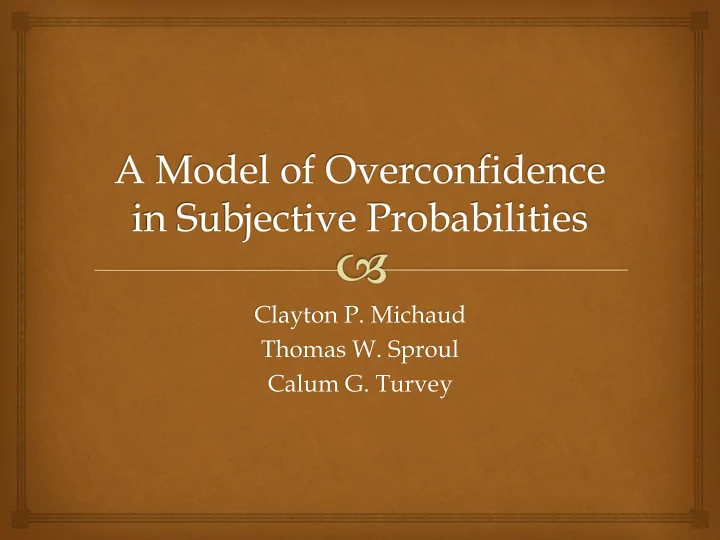

Clayton P. Michaud Thomas W. Sproul Calum G. Turvey
Introduction In 2013, Turvey et al. conducted a study looking at the potential to price insurance in regions that lacked adequate historical yield data using self-reported historic and future yield outcomes/expectations. Upon further analysis, he made an interesting finding- that the farmers he surveyed were systematically over optimistic about their future yield forecasts relative to their historic outcomes. On average, farmers anticipate yields in the coming year come from a distribution with a higher mean , and lower variance than historical experience justifies. This is an important result for two reasons: 1. It might explain the historic finding that farmers require much higher subsidies to induce crop insurance uptake than the traditional expected utility model would suggest 2. The leading model for the discrepancy between objective and subjective probability weightings, Kahneman and Tversky’s Cumulative Prospect Theory/Probability Weighting cannot explain this result because their model is unable to change the support of a probability distribution
Introduction In this research, we develop a Subjective Probability Transformation Model that parameterizes this overconfidence bias. We then use the parameters of this model to examine the population level distribution of this bias using expectation maximization (EM) to fit a finite Gaussian mixture model based on the scale and shift parameters from our model. We find that the bias can best be described as coming from 3 distinct classes. An optimistic group that makes up roughly 67% of our two samples. An unbiased group that represents roughly 21%. And a pessimistic group that comprises roughly 12%. We go on to explore how this three classes might further sub-divide and conclude by examining potential causes of this bias.
Yield Elicitation Survey Turvey et al., 2013 used a survey method to directly elicit risk perceptions and historic yield outcomes from rural Chinese farmers. In November 2011, 780 Chinese farmers were surveyed about their expectations for next year’s yield, as well as their historical yields. Survey took place in 3 counties (25 villages) in Shaanxi Province, China in October 2011. The survey had 9 sections with 117 questions in total. Only a portion of these were dedicated to crop insurance and the identification of crop yield risks. It was administered by 20 Chinese graduate students of the Northwest Agriculture and Forestry University supervised by faculty researchers. About 55% of respondents were male, with an average age of 48.72 years, and at least high school completion. On average respondents had farmed for about 27 years but this ranged from first year farmers to about 60 years. After eliminating incomplete questionnaires and famers who do not grow corn or wheat, we have 437 wheat and 442 corn observations, 394 of whom grew both.
The Survey Question Note: To avoid possible bias from representativeness, farmers were asked about their future expectations prior to being asked about their historic yields.
Comparison of Historic Outcomes and Future Predictions 1400 140 120 1200 y = 0.2361x + 26.894 100 R² = 0.1048 1000 Subjective Mode Subjective Range 80 800 y = 0.8099x + 199.17 R² = 0.5497 60 600 40 400 20 200 0 200 400 600 800 1000 1200 1400 0 50 100 150 200 250 Objective Mode Objective Range
Subjective Probability Transformation Model We model subjective risk as a function of objective/historic risk as follows: F = αr + βH where F and H represent the future historic yield respectively, α represents a shift in the location from a given reference point, and β represents a scaling of the variance/range of the objective distribution.
Parameterizing the Model After a number of tests we conclude that the maximum value serves as the most stable location parameter. Defining β as a nd solving for α, we get
Expectation Maximization (EM) Individual Mixing Parameters: In each step of the algorithm, we will update the class mixture probabilities: The first step is to calculate: which gives the ''membership probabilities'' for each individual. The updated mixture probabilities are then given by the average of these over all individuals, i :
Expectation Maximization The next step is the maximization step, in which we maximize with respect to the parameters, holding probabilities fixed:
Model Selection
3 Component Gaussian Mixture
6 Component Gaussian Mixture
3 Component Model ‘Unbiased’ 12% Pessimistic 21% Optimistic 67% When our Subjective Probability Transformation Model is applied to a symmetric Beta Distribution ( a, b = 5 )
Majority Group Under Alternative Distributional Shapes Left-skewed Beta Distribution Right-skewed Beta Distribution Historic mean from Beta Dist.: 1100 Historic mean from Beta Dist: 1000 • • Guarantee under 90% coverage: 990 Guarantee under 90% coverage: 900 • • Guarantee under 80% coverage: 880 Guarantee under 80% coverage: 800 • •
Factors Influencing Overconfidence Summary of Results 1. Overconfidence is significantly effected by historic losses. For each year since a historic min, farmers reduce • the scale of their future forecasts by 1%. Farmers who suffered the worst lost in the previous • year increase the scale of their forecasts by more than 13%. 2. On average, females are more optimistic, scaling down the range of their future forecasts by an average of 12%. 3. Our observed overconfidence cannot be attributed to increased yields resulting from technological advancements. Notes: *,**,*** signify significance at the 90, 95, and 99 percentile, respectively. Standard errors are in parentheses. Regression run on pooled data. The mean of the scale coefficient is 0.8 and the mean of Years Since Historic Min is 8.65.
Conclusion We find evidence that heterogeneity in overconfidence can best be described as coming from a 3-component finite Gaussian mixture model. An optimistic group that makes up roughly 67%. An unbiased group that represents roughly 21%. And a pessimistic group that comprises roughly 12%. Our optimistic majority class cleanly separates into 2 different classes of optimists- mild and extreme. Overconfident future yield forecasts seem to be effected by historical outcomes in a manner consistent with the ‘hot hand fallacy’ where the absent of recent losses causes increased overconfidence.
Recommend
More recommend